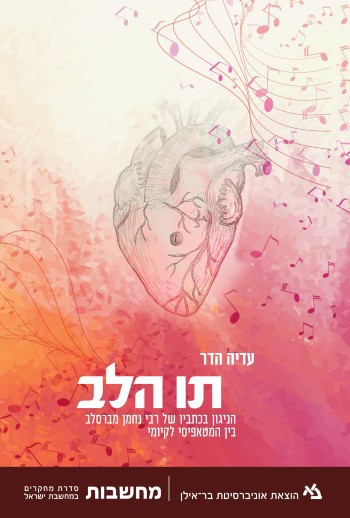
Recent years have seen a revival of the teachings of Rabbi Nahman of Braslav. What is it about Rabbi Nahman that, specifically in the New Age era, has more and more people drawn to his thought? Is it his existential mode that "touches" the soul of our generation or is it the nexus between spirituality and materiality?
This study purports to examine the status, roles and meanings of the nigun in the writings of Rabbi Nahman by way of comparison to the concept of music in the early Hasidic masters' homilies , from the Baal Shem Tov to Rabbi Shneur Zalman of Liadi.
Dr. Adaya Hadar holds a PhD in Jewish philosophy and is a researcher of Hasidism. Today she serves as the coordinator of the "Institute for the Study of Religious Zionism" at Bar-Ilan University.
Danacode: 110-20318 ISBN: 978-965-226-549-4 Language: Hebrew Pages: 226 Weight: 500 gr Dimensions: 17X24 cm Publication Date: 05/2021 Publisher: Bar-Ilan University Press
Contents
Preface 11
Introduction 15
Nigun as an act and nigun as an image 16
Music as a vehicle or as a value itself 17
An alternative model 19
a) Music as representing or alluding to a metaphysical being 19
b) Music as representing or referring to concrete existence 19
Esotericism and the turn to concrete existence in the writings of Rabbi Nahman 21
The text 26
A survey of the relevant research literature 27
Rabbi Nahman: Biography and thought 27
Music and Judaism 28
Rabbi Nahman and nigun 29
Song of mercy 31
The main thesis 33
Chapter I – Nigun in the writings of the early Hasidic masters 35
Nigun as an image 35
The “minstrel” image from the Book of Kings 2, chapter 3 verse 15 36
The image of “the psaltery and the harp” 45
The images of organ, violin and musical instruments 48
The images of dance and the vessel of song 51
Nigun as an act 54
Music as awakening 54
Music as rejoicing 55
Music, contemplation and spontaneity 59
Shofar and trumpets 62
The practical-mystical dimension 65
Cantors 68
Yodea Nagen – the skilled musician 75
The difference between song and chant 78
Song and prayer 83
Cantillation accents, nigun and prophecy 85
Rhythm and pulse 92
Music of the nations 93
The nigun of Ishmael and the nigun of Greece 96
Summary 101
Chapter II – Acoustic and musical motifs in the thought of Rabbi Nahman 103
Trumpets and the voice of the shofar 103
Shofar and unity 109
Interim summary 116
Moaning and sighing 117
Rhythm and pulse 120
Music as therapy 126
Palm on palm 131
Screaming 139
The voiceless scream 144
Summary 146
Chapter III - Music’s advantages according to the thought of Rabbi Nahman 147
The benefits of music as a religious instrument 147
Movement and dance 147
Passage from sadness to joy 148
Ecstasy and cleaving to God 150
Magic and unification of the sefirot 152
Joy that brings about mystical exaltation and prophecy 157
Dance as a religious objective rather than driven by impulse 158
The useful advantages of music – education, leadership 159
Music as political and educational seduction 160
Musical education – personal, psychological and religious 168
Music of the nations and music of the Tzaddik 171
Summary 174
Chapter IV – Esotericism and music in the thought of Rabbi Nahman 175
Existentialism and esotericism 177
Tzimtzum and esotericism 183
Reproof and esotericism 185
Prophecy and esotericism 187
Summary 188
Afterword 189
Appendix 191
Bibliography 193
Indexes 205
Dr. Adaya Hadar holds a PhD in Jewish philosophy and is a researcher of Hasidism. Today she serves as the coordinator of the "Institute for the Study of Religious Zionism" at Bar-Ilan University.


